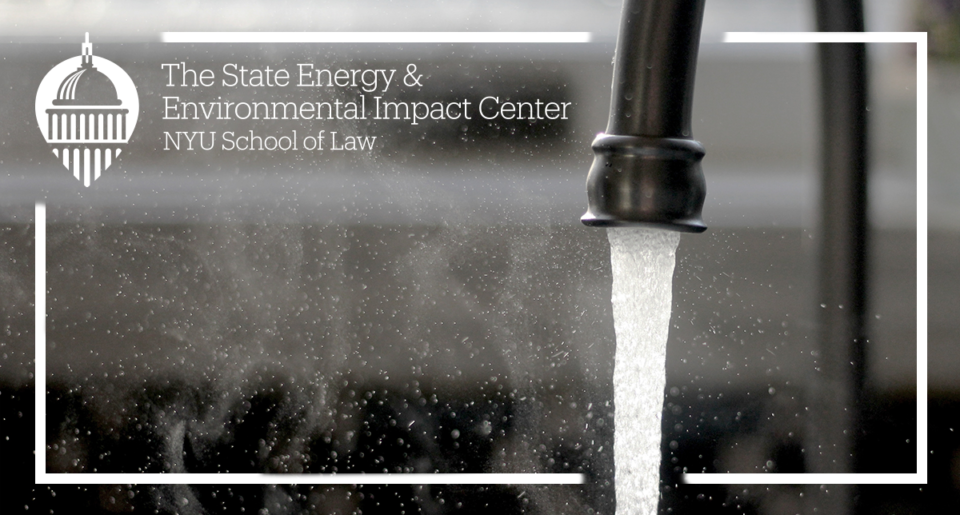Why the Controversy Around PFAS Chemicals, and What the EPA Can (and Should) Do About It
David J. Hayes (Past Executive Director) / February 8, 2019

Dangerous chemicals in drinking water seems so yesterday. After all, the Superfund law — signed by President Carter in 1980 — triggered a nation-wide cleanup of water supplies contaminated by industrial activities. And the venerable Safe Drinking Water Act is in place, protecting consumers from harmful contaminants in their water. Plus, Congress recently beefed up the Toxic Substances Control Act (TSCA) to give the EPA new authority to expedite action against harmful chemicals that present serious exposure risks.
Unfortunately, the EPA has yet to use any of these authorities to take decisive action regarding the alarming levels of toxic PFAS (per- and Poly Fluoro Alkyl Substances) confirmed to be present in hundreds of drinking water sources throughout the nation. Last May, former EPA Administrator Scott Pruitt hosted a National PFAS Leadership Summit. He promised, and his successor Andrew Wheeler subsequently confirmed, that the EPA would be releasing a now-overdue PFAS Management Plan by the end of the year. Skeptics, aware that the administration delayed release last summer of a devastating PFAS toxicological profile prepared by the Center for Disease Control (CDC) over fears that it would cause a “public relations nightmare,” are doubting that the EPA’s plan will show the leadership needed to take on the serious national environmental and health crisis posed by widespread PFAS contamination.
It will not be hard to judge whether the EPA’s forthcoming PFAS Plan is serious or not. When it hits your inbox, test the Plan against these four questions:
- Is the EPA committing to set an enforceable drinking water standard (an MCL or “maximum contamination level”) for PFAS?
- Is the EPA taking immediate action to reduce its non-regulatory health advisory level for PFAS downward from 70 parts per trillion, by a factor of 7 to 10, based on the results of the Center for Disease Control study that the administration tried to suppress?
- Will the EPA acknowledge that PFAS is a “hazardous substance” under the Superfund law and require that PFAS-contaminated sites be subject to testing, cleanup, and natural resources damages?
- Will the EPA identify PFAS as a priority chemical under the recently-amended TSCA law, which would require it to take expedited action to reduce unacceptable risks posed by PFAS?
Here’s why this matters: The PFAS chemical family includes hundreds of fluorine-contaminated compounds that are in ubiquitous, global use. Because PFAS are long-lasting and bioaccumulative, their widespread use means that all of us have been exposed to PFAS chemicals, have PFAS in our bloodstreams, and encounter PFAS in the environment including, most dangerously, in public drinking water systems. Hot spots include drinking water supplies near military bases and airports, where huge volumes of PFAS-containing firefighting foam agents have been routinely used in training exercises.
Scientists recently completed a large-scale human epidemiology study that confirmed a direct link between PFAS and cancer (kidney and testicular), ulcerative colitis, liver and thyroid damage, developmental risks to fetuses, and elevated cholesterol. Based on this study, and others, the EPA identified its current, non-regulatory drinking water health advisory of 70 parts per trillion for PFAS in 2016. The CDC’s August 2018 study that the White House was reluctant to release, however, found that PFAS can be responsible for adverse health effects at human levels of exposure significantly less than the EPA’s current 70 parts per trillion advisory level. The CDC’s findings suggest that the EPA has a responsibility to take more aggressive action, and to set a much lower exposure threshold.
The current void in federal leadership on PFAS has largely left the states on their own, forcing them to rely upon state resources, expertise, and legal authorities that often do not match up with the scope of the PFAS challenge or the muscular federal authority over chemicals regulation and remediation. Not surprisingly, with only a (now-questionable) health advisory in place, and no uniform, enforceable federal drinking water standard, states are applying widely-divergent regulatory and cleanup approaches for PFAS – or none at all. And because the feds have largely ignored the Superfund law’s powerful authority to address PFAS contamination (which was designed for precisely this type of national legacy contamination problem), frustrated state attorneys general in Ohio, New York, Minnesota, and other states have had to bring lawsuits to confront pollution risks that the feds have an obligation to address.
So, again, the question is whether the EPA will step up and use the tools that Congress has given it to tackle the national health and environmental threat posed by PFAS contamination. Comparing the forthcoming Plan against the four questions noted above will give us the answer.
This commentary, and others like it, are included in the biweekly “Legally Speaking” newsletter released by the State Energy & Environmental Impact Center at the NYU School of Law. Sign up for Legally Speaking here.
